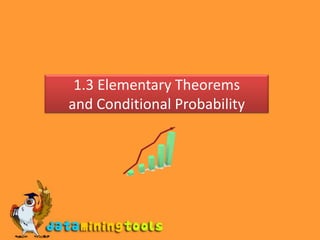
Theorems And Conditional Probability
- 1. 1.3 Elementary Theoremsand Conditional Probability
- 2. Theorem 1,2 Generalization of third axiom of probability Theorem 1: If A1, A2,….,Anare mutually exclusive events in a sample space, then P(A1 A2….An) = P(A1) + P(A2) + …+ P(An). Rule for calculating probability of an event Theorem 2: If A is an event in the finite sample space S, then P(A) equals the sum of the probabilities of the individual outcome comprising A.
- 3. Theorem 3 Proof: If E1, E2,……Enbe the n outcomes comprising event A, then A = E1E2 …… En. Since the E’s areindividual outcomesthey are mutually exclusive, and by Theorem 1, we have P(A) = P(E1E2 …… En) = P(E1) + P(E2) + …+ P(En). General addition rule for probability Theorem 3: If A and B are any events in S, then P(AB) = P(A) + P(B) – P(AB).
- 4. Theorem 4 Note: When A and B are mutually exclusive so that P(AB) = 0, Theorem 3 reduces to the third axiom of probability therefore the third axiom of probability also called the special addition rule Probability rule of the complements Theorem 4: If A is any event in S, then P( ) = 1 – P(A).
- 5. Proof are mutually exclusive by Proof: Since A and definition and A = S. Hence we have ) = P(S) = 1. P(A) + P( ) = P (A P( ) = 1 – P( ) = 1 – P( S ) = 0. If A B then P(B) = P(B) - P(A) P(A B) = P(A) + P(B) - 2 P(AB)
- 6. Conditional Probability If we ask for the probability of an event then it is meaningful only if we mention about the sample space. When we use the symbol P(A) for probability of A, we really mean the probability of A with respect to some sample space S. Since there are problems in which we are interested in probabilities of A with respect to more sample spaces than one, the notation P(A|S) is used to make it clear that we are referring to a particular sample space S.
- 7. Conditional Probability P(A|S) conditional probability of A relative to S. Conditional probability: If A and B are any events in S and P(B) 0, the conditional probability of A given B is P (A|B) is the probability that event A occurs once event B has occurred
- 8. Conditional Probability (cont’d) Reduced Sample Space A B S B A P(A|B) measures the relative probability of A with respect to the reduced sample space B
- 9. Conditional Probability (cont’d) If A and B are any two events in the sample space S, Then the event A is independent of the event B if and only if P(A|B) = P(A) i.e. occurrence of B does not influence the occurrence of A. But B is independent of A whenever A is independent of B. A and B are independent events if and only if either P(A|B) = P(A)or P(B|A) = P(B)
- 10. Conditional Probability General multiplication rule of probability Theorem 5: If A and B are any events in S, then P(AB) = P(A)· P(B|A) if P(A)0 = P(B)· P(A|B) if P(B)0 Special product rule of probability Theorem 6: Two events A and B are independent events if and only if P(AB) = P(A)· P(B)
- 11. The mutually exclusive events are not independent unless one of them has zero probability. If an event A is independent of itself then P(A) = 0 or P(A) = 1 If the events A and B are independent, then so are events and B, events A and and events and .
- 12. Bayes’ Theorem Let S be a sample space and B1, B2,….Bnbe mutually exclusive events such that S = B1B2 …… Bn and A be an event in the sample space S. Then A = AS = A(B1B2 …… Bn) = (A B1) (A B2) ……. (A Bn). Since all A Bi ’s are mutually exclusive events P(A)=P(AB1) + P(AB2) +……. + P(ABn).
- 13. Bayes’ Theorem or But from multiplication rule for probability P(ABi) = P(Bi)·P(A|Bi), for i = 1, 2, …, n hence we have
- 14. Bayes’ Theorem Rule of elimination or rule of total probability Theorem 7 : Let A be an event in a sample space S and if B1, B2,……Bn are mutually exclusive events such that S = B1B2 …… Bnand P (Bi) 0 for i = 1, 2, …, n, then
- 15. Bayes’ Theorem To visualize this result, we have to construct a tree diagram where the probability of the final outcome is given by the sum of the products of the probabilities corresponding to each branch of the tree. P(A|B1) B1 A B2 P(A|B2) P(B1) A Figure: Tree diagram for rule of elimination P(B2) P(Bn) P(A|Bn) A Bn
- 16. Bayes’ Theorem (cont’d) from the definitionof conditional probability but according to multiplication rule of probability, we have P (Bk A) = P(Bk)·P(A|Bk). Hence, we have
- 17. Bayes’ Theorem Using rule of total probability, we have following result. Bayes’ Theorem Theorem 8: Let A be an event in a sample space S and if B1, B2,……Bn are mutually exclusive events such that S = B1B2 …… Bn and P (Bi) 0 for i = 1, 2, …, n, then for k = 1, 2,….., n.
- 18. Bayes’ Theorem This theorem provides a formula for finding the probability that the “effect” A was “caused” by the event Bk. Note: The expression in the numerator is the probability of reaching A via the kth branch of the tree and the expression in the denominator is the sum of the probabilities of reaching A via the n branches of the tree.
